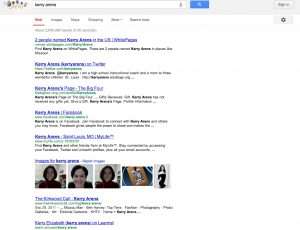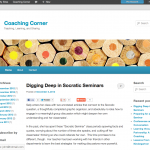Have you Googled yourself yet? While it might seem a vain act, Googling yourself gives you a decent snapshot of your current digital footprint. Your students, their parents, your employers, and anyone who wants to know more about you might take this first step. Some of us already have pages of information on Google and others might just appear as a listing in the White Pages.
Either way, we should take control of our future digital footprints and model for our students the creation and maintenance of an online presence since in “a recent survey by Kaplan Test Prep, 27% of college admissions officers say that they Google applicants and 26% check their Facebook profiles during the admissions process. A whopping 35% of admissions reps said they reviewed something on these sites that negatively affected a student’s chances of being accepted. Since last year, this figure has nearly tripled” (College Admissions: How Social Media Can Ruin Your Application). If you don’t like what you see when you map your digital footprint, consider tidying up with tips in this article. And, before you post another picture, join an additional site, or vent in a discussion forum, think like a writer.
Purpose and Audience: Maybe this stems from being an English teacher for a number of years, but the advice I often give people who are entering the digital world is to think like a writer and focus on purpose and audience before opening their iPads or laptops.
What is your purpose for going digital?
- sharing ideas
- teaching
- networking
- inspiring action
- learning from others
Who is your audience?
- self
- peers/colleagues
- employers
- students
- parents
- friends/family
Is Facebook a place for me to catch up with friends and family across the country, or is it a place where my students might learn from me and their peers? The answers to these questions might shape not only the voice and content of your digital creations but the location as well.
Publishing: If I want my students to demonstrate their understanding of a concept, might they post to my blog, FB, or Instagram? Which of the following tools might be most powerful for my purpose and audience?
- personal website
- course website (via Edline/Google sites/iWeb)
- social networks (FB, Twitter, blog, Google+)
- professional networks (LinkedIn, Academia.edu)
- media sharing (youtube, Flickr, Instagram)
- interest sharing (Pinterest, Good Reads)
- webtools (Quia, Diigo, ShowMe, Linoit)
Reflection/Revision: Writers request feedback from editors and peers, make adjustments, and try again to more successfully achieve their goals. How do we know our digital presence is working if we don’t ask our audience for their comments and suggestions? What might we rethink based on the feedback we receive?
An instructional coach can support you in this process of planning, publishing, and reflecting.
Your turn: What are your goals for creating a digital presence? Which tools have helped you reach them? What have you learned about these tools and how they work together? Post your thoughts and questions here or on Twitter, using the hashtag #khspd.



It is important to constantly check your digital foot print. The best way to do this is to make sure you are logged out of all your social media websites. That way you get a true picture of your foot print. I do this on a monthly basis. So long as you are away from the first three pages within a google search you should be good. Most employers stop searching after those. This information comes from a social media expert, Davina Horton, who works for Hubbard Radio. https://twitter.com/davinajanine
I’ve always wondered how Google (or any search engine) chooses when it lists its sites it does. I always assumed it was based on those most frequently visited sites first. I didn’t think it was anything i have any control over. In the image search, I guess I’m always surprised to see my picture 2 or 3 times on the first page since Robert Becker is fairly common. (Really weird, there was a Bob Becker professional baseball player who was born on 10/11/51, and my birthdate is 10/11/61!!!). I just image googled my daughter Elizah Becker, thinking that with such an unusual spelling of her first name, she posts a LOT of photos on facebook… None of her pictures are there, but the very first image that appears is of a tombstone for one “Eliza H. Becker” 1855-1919… Very spooky…
Very important topic that we don’t address directly enough with our students right now, but as you outline an unavoidable conversation now.
I was at a workshop with Dr. Alec Couros (education prof. at University of Regina) at IntegratED last year- he is an excellent resource- presents on this topic around the world while addressing it head on with his students. Here is his latest slideshare, you miss the commentary but from online searches to memes he covers all the bases http://bit.ly/QTRDnp
Pingback: Research Paper Exemplar Blog › SLC: Research Paper Structure